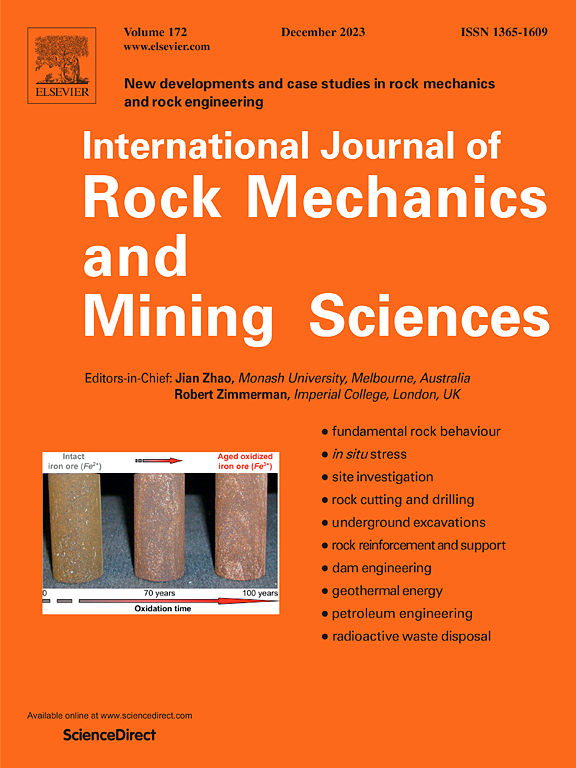韧性福斯克大理石和脆性库鲁花岗岩在渐进破坏过程中组成矿物的纳米力学特性变化
IF 7.5
1区 工程技术
Q1 ENGINEERING, GEOLOGICAL
International Journal of Rock Mechanics and Mining Sciences
Pub Date : 2024-10-01
DOI:10.1016/j.ijrmms.2024.105853
引用次数: 0
摘要
实验研究了二级库鲁花岗岩和一级法斯克大理石组成矿物的纳米级弹性模量和硬度。目的是将微裂纹模式与矿物的纳米力学性能联系起来,帮助理解矿物的纳米力学性能在脆性和韧性行为中的重要作用。圆柱形岩石试样在峰值前和峰值后阶段均受到不同应力水平的单轴加载。然后将试样卸载至零,从每个试样上制备两个薄片--一个平行于加载方向,另一个垂直于加载方向。对薄片进行纳米压痕测试,以测量岩石中主要成分矿物的弹性模量和硬度。测试结果表明,当施加的应力超过岩石单轴抗压强度的 80% 时,岩石的弹性模量和硬度都会突然下降。同时,这两种属性的值随着矿物受损程度的增加而变得更加分散。较硬的石英和微晶石的粒内裂缝数量明显少于较软的方解石。方解石中大量的粒内裂缝耗散了 I 级大理石中的大部分应变能,因此岩石在破坏后不会爆裂。二级花岗岩中的石英和微晶石中产生了少量粒内裂缝,因此矿物中的大部分应变能都被释放出来,使岩石在破坏后喷出。因此,晶内裂缝是决定岩石是否易爆的关键因素。本文章由计算机程序翻译,如有差异,请以英文原文为准。
Changes in the nanomechanical properties of the constituent minerals in the ductile fauske marble and the brittle kuru granite during progressive failure
The nanoscale elastic moduli and hardness of the constituent minerals of the Class II Kuru granite and the Class I Fauske marble were experimentally investigated. The aims were to correlate the microcrack patterns with the nanomechanical properties of the minerals, and to help understand the important roles of the nanomechanical properties of the minerals in brittle and ductile behaviors. Cylindrical rock specimens were uniaxially loaded to various stress levels in both the pre- and post-peak stages. The specimens were then unloaded to zero, and two thin sections –– one parallel with and the other perpendicular to the loading direction –– were prepared from each specimen. Nano-indentation tests were conducted on the thin sections to measure the elastic moduli and hardness of the major constituent minerals in the rocks. The test results showed that both the elastic moduli and hardness of the minerals abruptly decreased when the applied stress was above 80 % of the uniaxial compressive strength of the rock in the pre-peak stage and also in the entire post-peak stage. At the same time, the values of the two properties became more scattered with increasing damage to the minerals. The number of intragranular cracks was significantly less in the harder quartz and microcline than in the softer calcite. The abundant intragranular cracks in the calcite dissipated most of the strain energy in the Class I marble, such that the rock was not burstable after failure. A small number of intragranular cracks were created in the quartz and microcline in the Class II granite, such that most of the strain energy in the minerals was released to eject rock after failure. Intragranular cracking is thus a key factor in determining whether a rock is burst-prone or not.
求助全文
通过发布文献求助,成功后即可免费获取论文全文。
去求助
来源期刊
CiteScore
14.00
自引率
5.60%
发文量
196
审稿时长
18 weeks
期刊介绍:
The International Journal of Rock Mechanics and Mining Sciences focuses on original research, new developments, site measurements, and case studies within the fields of rock mechanics and rock engineering. Serving as an international platform, it showcases high-quality papers addressing rock mechanics and the application of its principles and techniques in mining and civil engineering projects situated on or within rock masses. These projects encompass a wide range, including slopes, open-pit mines, quarries, shafts, tunnels, caverns, underground mines, metro systems, dams, hydro-electric stations, geothermal energy, petroleum engineering, and radioactive waste disposal. The journal welcomes submissions on various topics, with particular interest in theoretical advancements, analytical and numerical methods, rock testing, site investigation, and case studies.

 求助内容:
求助内容: 应助结果提醒方式:
应助结果提醒方式:


